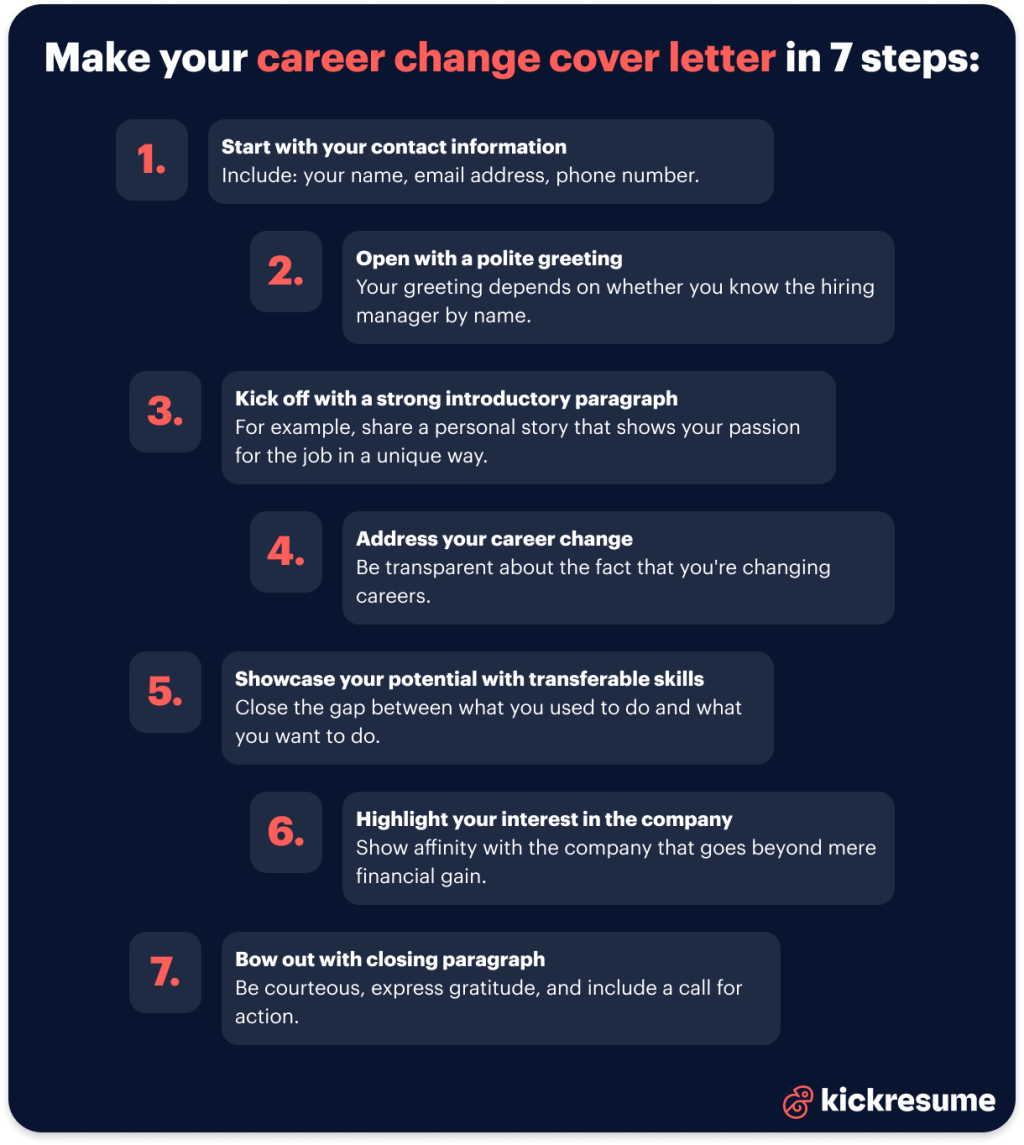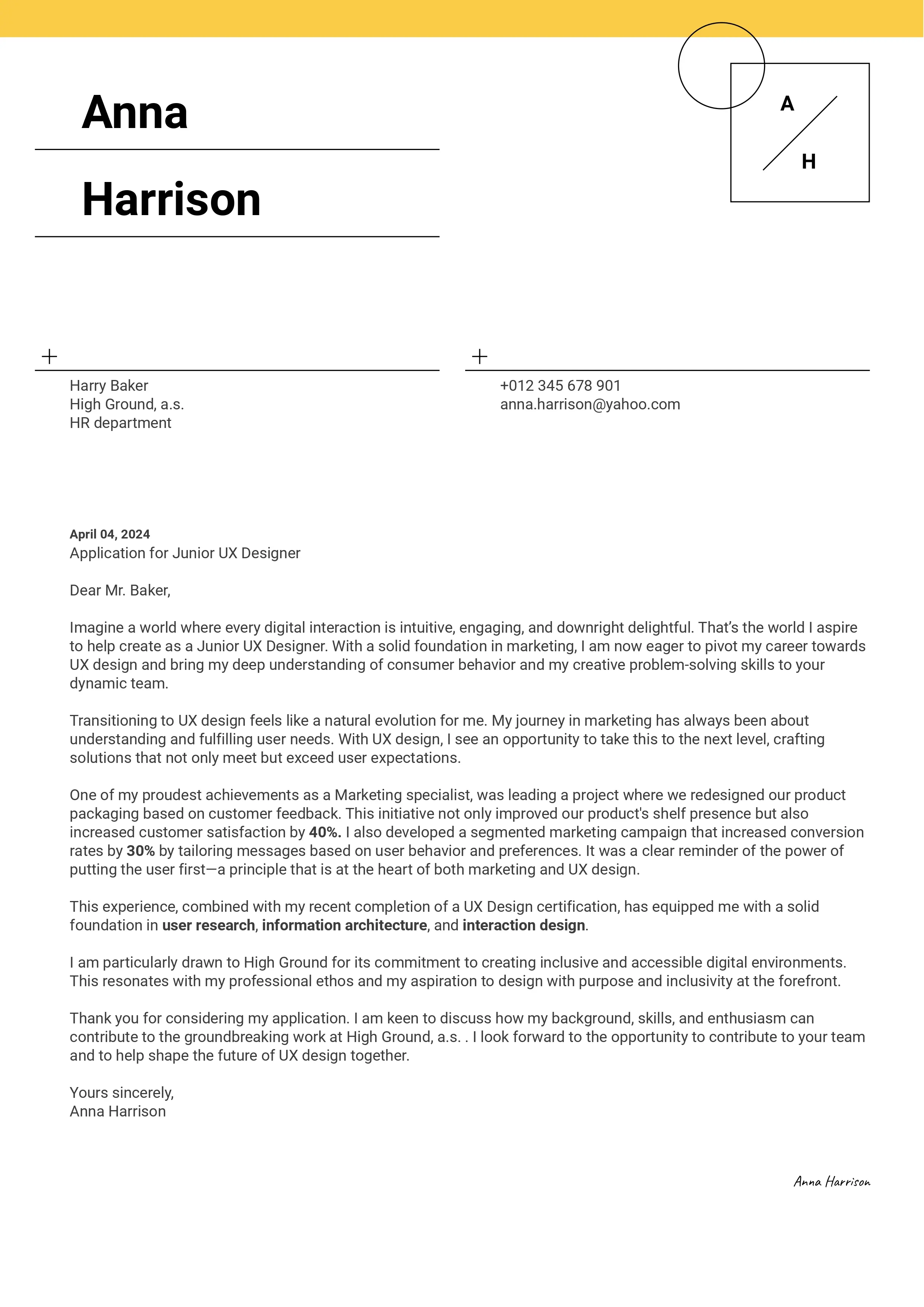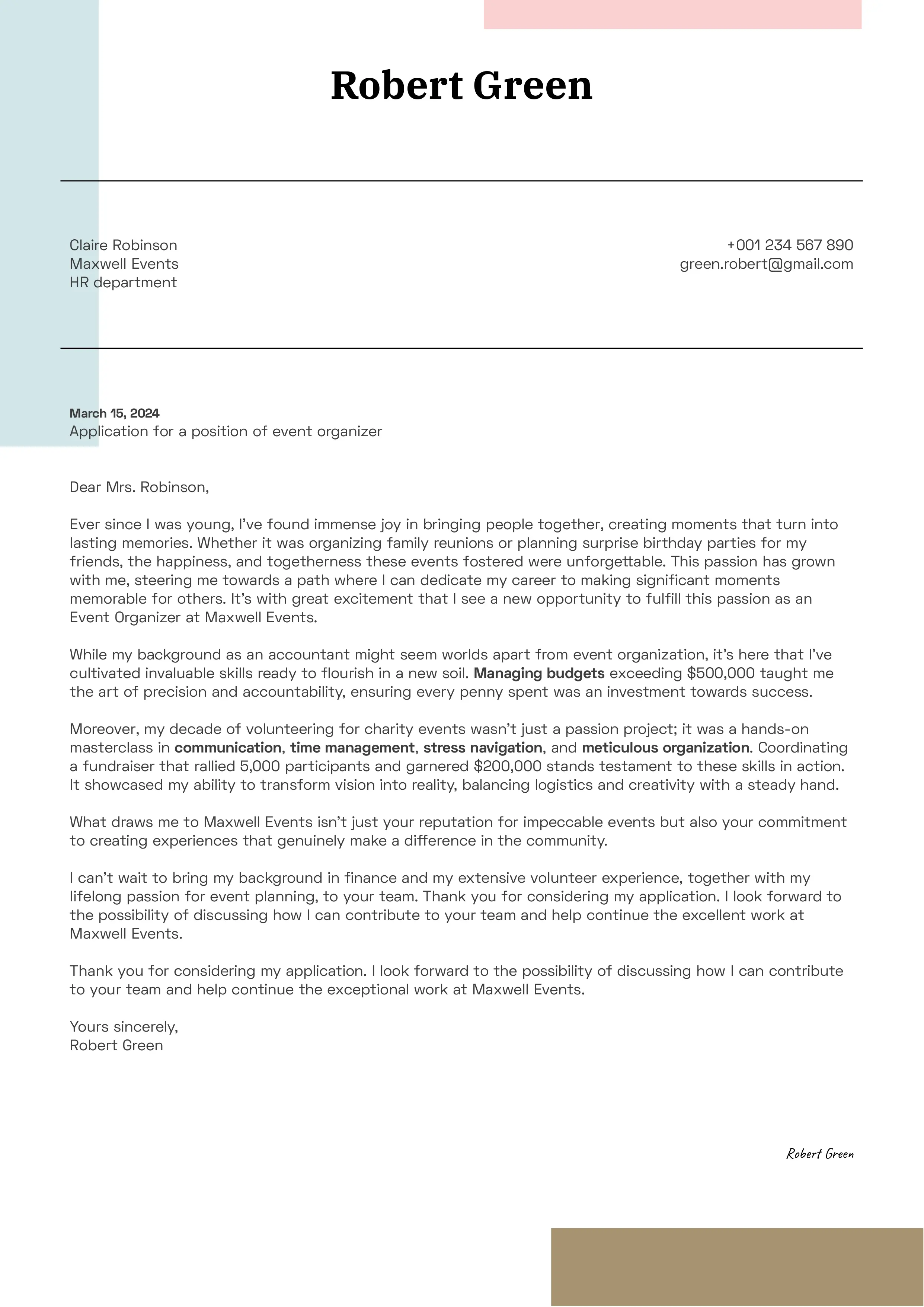How do you write a career change cover letter? You write it well, of course! After all, the cover letter can make or break your chances at successfully completing a career switch.
Not that career change is easy to begin with. It can often feel like trying to make your way through an obstacle course — no matter where you turn, new challenges just keep popping out of nowhere. And yet, a staggering 58% of workers are thinking about changing careers, according to a FlexJobs survey.
But inevitably, there comes a moment when you'll need to justify your choice to a new employer and prove that you're more than well-equipped to handle the new responsibilities.
And what better way to do that than via a cover letter!
So, if you want to change careers this year, keep reading to discover:
- What is a cover letter;
- Whether you should write a cover letter for career change;
- How to write a cover letter for a career change in just 7 steps;
- And, 3 career change cover letter examples.
What is a cover letter?
A cover letter is a formal document which, together with a resume, makes up the core of any well-rounded job application.
It serves as the first point of contact between you and the recruiters. And for that reason, it's responsible for making the first impression (good or bad).
Unlike a resume, a cover letter allows you to:
- share a bit of your personality,
- provide context for your background,
- and present your career aspirations.
It's your chance to make a compelling case for why you should be considered for the role, beyond just the bullet points on your resume.
Should you write a cover letter for career change?
Yes, you absolutely should!
Let us explain: A resume is great for presenting the numbers and objective facts. But it doesn't offer you much space for creating a compelling narrative.
When you're applying for a job as a career changer, you're already at a disadvantage - you're missing one of the crucial ingredients for the ideal job candidate.
An average recruiter needs only 6 seconds to look at your resume and recognize your lack of experience as a problem. And that's reason enough to move your application from the list of potential candidates to the bin.
But it's all about perspective. And perspectives can change based on how you frame it — is your career change really a shortcoming? Or is it a testimony to your passion, dedication, and willingness to leave the comforts of your old job for a new one?
How to write a cover letter for a career change in 7 steps
Although there isn't any definitive or universal manual on how to write the perfect career change cover letter, following these 7 steps will allow you to craft one which hits all the marks that matter.
- Start with your contact information
Place your contact information (including: your name; professional email address; phone number; link to your web page/portfolio/social media accounts if relevant) in the top section of your cover letter.
- Open with a polite greeting
If you can find the name of the hiring manager, simply greet them with “Dear [full name],” or “Dear Mrs/Mr [last name],” .If not, you can address the letter more generally to “Dear Hiring Manager,” or “Dear Recruitment Office,” .
- Kick off with a strong introductory paragraph
Capture the hiring manager's attention by making your goals and motivation for the new job position known. For example, you can share a personal story or an anecdote that shows your passion for the job in a unique way.
- Address your career change
Despite any possible discomfort, you have to be transparent about the fact that you don't have any previous work experience in the given job position. Any attempt at camouflaging could reflect badly on your professionalism and integrity.
- Showcase your potential with transferable skills
You must prove that despite not having previous work experience in this particular position, you're still able to handle the responsibilities and duties that define it. For this purpose, use transferable skills that you've picked up in your former profession, during volunteering, through courses, or thanks to your lifelong interest in the job position.
- Highlight your interest in the company
Additionally, establish a sentimental connection between yourself and the potential employer. You can reference, for example, the company's mission, values, recent projects, or any charities/non-profit organization the company promotes.
- Bow out with closing paragraph
Finally, in the closing statement you should:
1. Reiterate your desire to work for the company,
2. Thank the hiring manager for their time and consideration,
3. Include a call for action,
4. Sign off professionally.
Now, we'll look at each of these steps in more detail.

Step 1: Start with your contact information
First of all, you need to deal with the basic conventions. After all, a cover letter is still a formal letter, though in digital form. And every formal letter needs to contain details about its sender.
These include:
- your name,
- professional email address,
- current phone number,
- link to online portfolio/web page/social media accounts (if relevant).
Make sure that all your contact information is updated and spelled correctly. This may seem obvious, but you'd be surprised how easily these small mistakes can creep in.
Place your contact information at the top of your career change cover letter so that they draw the attention of recruiters immediately.
Don't forget to also mention the company's contact information or that of its hiring manager. This isn't all that necessary but again…formalities.
Step 2: Open with a polite greeting
If you're lucky, the name of the hiring manager (or recruiter) will be mentioned somewhere in the job posting you're responding to. Unfortunately, that's not always the case.
But with the power of the internet by your side, this shouldn't be much of a problem. Try to dig up the addressee's name from the company's official website or their LinkedIn profile.
It's always better to address the hiring manager by their name — it helps establish a personal connection between you two.
But don't overthink it! A simple “Dear [first name] [last name],” or “Dear Mrs/Mr [last name],” will do just fine.
In case the hiring manager's name is nowhere to be found, you can use one of these 5 email salutations.
Step 3: Kick off with a strong introductory paragraph
The purpose of your cover letter's introductory paragraph is to give the reader a little something to make them interested in the rest of your cover letter.
Normally, you'd try to hook the reader by pointing out that you fulfill the main candidate requirements. Like so:
Opening paragraph example
But since you're switching careers, this formula won't work for you. Instead, you could charm the recruiters with your:
- motivation,
- passion,
- drive,
- or purpose.
These are the cards you need to play when writing a career change cover letter!
So, don't be afraid to get personal here — share a story that depicts the workings behind your decision to switch careers. Just remember to stay professional! It's a fine line, we know, but you must tread it expertly.
For example, your introduction could look something like this:
Opening paragraph for career change cover letter example
Step 4: Address your career change
And now it's time to acknowledge the elephant in the room!
While it may be tempting to conceal the fact that you're trying to enter a new profession, don't hide it. In the end, it could cause you more harm than good.
Because the recruiters will know just by taking a single glance at your career change resume.
Fail to address this, and you're running the risk of giving the impression that you're unprofessional. Or that you're being dishonest. And either of the two can leave a really bad taste.
So, when writing about your career switch, be upfront, be direct, but don't be apologetic! Remember, you need to persuade the recruiters that you're confident in your abilities.
Step 5: Showcase your potential with transferable skills
Basically, this part of your career change cover letter is all about closing the gap between what you used to do and what you want to do.
In other words, you must show that you have more to offer besides your unrivaled motivation.
And the best way to do this is by talking about any relevant transferable skills you've picked up along the way. The keyword being relevant!
For example, the project manager skills you developed while working in marketing may translate well into leading teams in pretty much any industry. Or the insights into SEO that you've gained as a copywriter can become valuable in your new PR position.
In short, your transferable skills can be anything from hard skills like computer proficiencies, to soft skills like problem-solving, leadership, communication, team management, and so on.
Besides abilities you've gained from a previous employment, you can also focus on those you've acquired thanks to:
- volunteering,
- lifelong interest in a specific profession,
- personal projects and ventures,
- and training/certifications/courses.
But don't just list them!
Instead, you need to clearly demonstrate how your new employers would benefit from your skills despite coming from a different background.
Here's a brief how-to:
- Firstly, you need to brainstorm about what skills you possess that might be useful in your new job position.
- Then, align them with the requirements outlined in the job posting.
- Out of the bunch pick 2-3 skills that are essential for succeeding in the new position.
- Finally, provide a proof that you have these skills by giving examples of how you utilized them in your previous job (back your claims by quantifiable data if possible).
Transferable skills on a cover letter example
Step 6: Highlight your interest in the company
And don't just say that you want to work for them because they pay more. In fact, don't mention salary at all!
In this section of your career change cover letter, you need to show your affinity to this particular company that goes beyond mere financial gain. Why them?
But before you jump into it headfirst, do these three things: research, research, and more research!
Read their website, stalk their social accounts, go through their quarterly reports, pull up any news articles, look at their LinkedIn page — and do all that without reservations. And try to find answers to the following questions:
- What is the company culture like?
- What are the company values/mission?
- What projects did they work on?
- What events did they organize?
- Do they support any non-profit organizations?
Let the information you learn be your pointers. And then, all you need to do is try to be as honest as you can.
For your inspiration, consider this example:
Showing affinity with company example
Step 7: Bow out with a strong closing paragraph
And now, all that's left to do is apply a few finishing touches.
The final paragraph of your career change cover letter should include:
- A reiteration of your desire to work for the company. But only briefly.
- An expression of gratitude. Thank the hiring manager for their time and consideration.
- A call for action. Such as expressing your wish for a personal meeting.
- An appropriate sign-off. Depending on how you greeted the recipient of your cover letter, you can sign off with either “Yours sincerely,” or “Best regards,”. If you addressed the recruiter by their name, sign off with the former; if not, use the latter.
In case you'd like to see how to close the curtain with finesse, these 8 great cover letter endings are just waiting to be read.
Career change cover letter examples
And now, let's put all these steps together and look at 3 complete cover letters, made with our cover letter templates.
Why does it work?
- This example does a great job of making the text digestible and easy to follow. Because the last thing you want is to have your cover letter looking cluttered and disorganized.
- Another interesting element is the inclusion of bullet points. It’s yet another way of making you cover letter visually distinct.
#2 Career change cover letter example

What’s good about this example?
- The candidate’s contact information stands apart from the rest of the text, making it easy to spot.
- Also, this person manages to bridge the gap between marketing and UX design by identifying a principle common for both - customer satisfaction. This motive is then repeated throughout the whole cover letter.
- Another thing worth pointing out is the detailed description of the candidate's most relevant achievements.
#3 Career change cover letter example

What can you take away?
- This cover letter example opens with a bang! The candidate communicates his passion for the new job load and clear. From his writing, it's obvious that his career change was inspired by a genuine desire to facilitate memorable events for his clients.
- Despite the fact that accountancy and event organization have very little in common, Robert was able to draw transferable skills from his volunteering experience.
- And, to better illustrate the scope of his skills, Bob provided quantifiable data to bolster his competencies.
For more cover letter samples, feel free to browse our cover letter database.
Key takeaways: Career change cover letter
To sum it all up, a compelling career change cover letter is your best bet at persuading hiring managers to give you a chance.
As a career changer, you probably have little to no work experience that directly relates to the profession you want to transition to. That's why you should focus your cover letter on:
- your passion and dedication to the job
- any relevant transferable skills
- explaining your reasons for the professional pivot
To craft an effective cover letter that addresses all three themes mentioned above, we recommend following these simple 7 steps:
- Start with your contact information
- Open with a polite greeting
- Kick off with a strong introductory paragraph
- Address your career change
- Showcase your potential with transferable skills
- Highlight your interest in the company
- Bow out with closing paragraph
Finally, if you've just started looking into a career change because you're unhappy in your current job but don't know what profession to focus on, feel free to explore how to become:
- an architect,
- a real estate agent,
- a psychologist,
- a human resources manager,
- a chiropractor,
- or a Scrum Master.
- How long should my career change cover letter be?
As a rule, your cover letter shouldnt exceed one page! Anything longer than that and you're risking discouraging the hiring manager from ever reading it. Your cover letter should recount the best parts of your professional life and your motivation, not the whole story.
- What common mistakes should I avoid?
By far the biggest mistake you can make is NOT customizing your cover letter to fit specific requirements of the job posting you're responding to. Other minor, but no less significant, mistakes include: spelling errors, grammar mistakes, and typos. So make sure you proofread your cover letter before hitting send.
- What tone should I use in my cover letter?
Although your cover letter is still a formal document, it's also your chance to establish a connection with the recruiter on a personal level. And your tone of voice should reflect both of these realities. Be professional, but not too stiff; confident but not arrogant; friendly, but not too nonchalant.
- Should I talk about my previous employer when discussing my professional background?
That depends.You can name-drop your previous employer if you feel like it will give you more professional credit. But don't dwell on this for too long. And never EVER speak badly about your past employer, colleagues, or team. Such behaviour reflects negatively on your professionalism and integrity.
- How can I make the cover letter writing process easier?
When you're looking for a new job, every moment is precious. That's why you should consider trying an AI tool that helps you create the first draft of your cover letter. Simply enter your most recent job title, press the “Use AI Writer” button and the AI writer will generate a cover letter for you. And the best thing is, you can try it for free.




